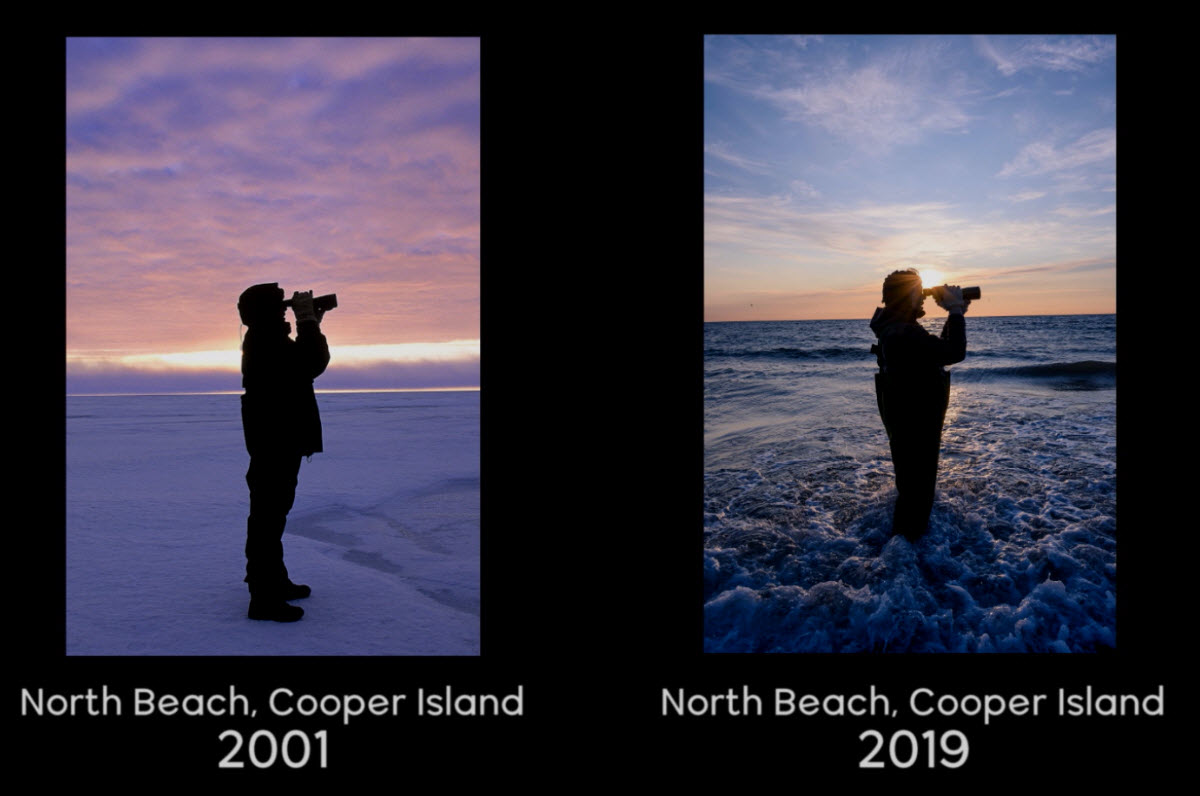The ice pack on Cooper Island has changed dramatically in the 18 years since these 2 pictures were taken on the same day, at the same location. See for youself with our interactive display.
Category: An indicator of arctic change
Start of the 45th field season
Even after 44 years, preparing for the field season to study Black Guillemots on Cooper Island is a time of excitement and anticipation as I gather the gear and supplies needed to survive and conduct research for three months on a remote Arctic island. This year the excitement was tempered with a high level of...
Long-term Data Collection Serves Many: Cooper Island study aids graduate students studying climate change
Graduate student Drew Sauve recently returned from Cooper Island. He describes his collaboration with George in this guest post. The Black Guillemots on Cooper Island are one of many wild populations that are responding to climate change by changing when they lay their eggs. These Arctic seabirds want to lay their eggs as soon as...
Arctic Worries: Climate change impacts communities and wildlife in the Arctic
Science writer Jenny Woodman of Proteus writes about Cooper Island research and the current field season. George Divoky frets–with good reason. In 2016, CNN Correspondent John D. Sutter called him the man who is watching the world melt. The description is as distressing as it is apt. George sends us regular dispatches from a small field camp...
Seabirds and Sea Ice
Over most of its range the Black Guillemot is a nearshore seabird, occupying coastal waters during both the breeding and nonbreeding seasons, as do other members of the genus Cepphus. Pelagic or open ocean waters can offer abundant prey resources, but these options are often distant, patchy and unpredictable. The nearshore typically offers seabirds a smaller but...
Work Worth Doing: Reflecting on 44 years in the Field
The Cooper Island Black Guillemot study was recently mentioned in an Associated Press story by Seth Borenstein about researchers who “accidentally” began studying climate change. A number of scientists measuring a biological phenomenon have encountered unanticipated effects from climate change and understood those effects were more important, both biologically and politically, than what originally motivated them to...
Cooper Island Research Part of SENSEI: Sentinels of the Sea Ice
In 2015 Christophe Barbraud of the Centre d’Etudes Biologiques de Chizé began assisting us with the analysis of the four-decade demographic database we have obtained from the Cooper Island Black Guillemot colony. Christophe is a highly respected avian demographer whose study species include the Snow Petrel, an ice-obligate Antarctic seabird, as well as a number of other seabirds. ...
Cooper Island Video part of NOAA’s “Ocean Today: Every Full Moon” Outreach
The National Oceanic and Atmospheric Administration interviewed George via Skype and put together a concise educational video on the Cooper Island Black Guillemot research and the record warmth of 2016 as part of their Ocean Today Every Full Moon series, a resource for educators. The Cooper Island video is at this link :
Guillemot Early Breeding Season and New Cooper Island Publications
Fieldwork at the Black Guillemot colony on Cooper Island began in early June, where I began the fifth decade of research on a remote island in a rapidly changing Arctic. Just how rapidly that change is occurring was obvious on the first day in the field, June 11, 2015, when I discovered that egg...
Current Sea Ice Status
The Black Guillemots on Cooper Island have seen their nesting success reduced over the past four decades as sea ice decline has reduced the availability of their preferred prey. Sea ice extent in the Arctic on June 15, 2015 was 9.1 (only one decimal point) million km sq., 10 percent less than the average...


